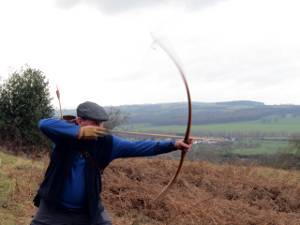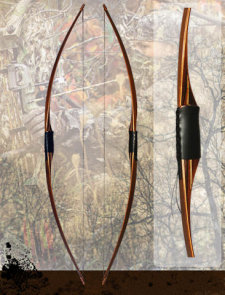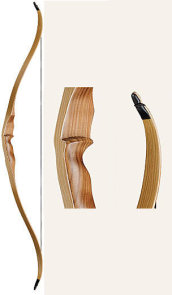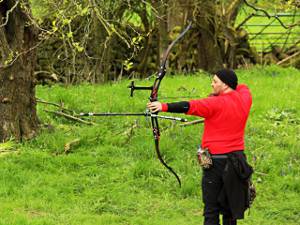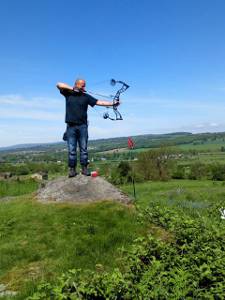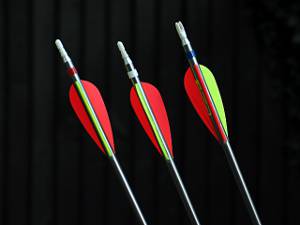Archery Equipment
Field archery, like any other sport/pastime has manufacturers that will sell you the next must have piece of kit that will get you better results or you just won't be able to live without. Here we will just list the basics that will allow you to enjoy archery with a minimum of fuss.
Longbow
The longbow of the middle ages was made of a single stave of Yew with the sapwood (on the outside of the tree) forming the back and the heartwood the belly of the bow. This forms a natural "laminate". Its modern counterpart is made up of laminates of various types of wood glued to form a laminate. Being a traditional bow, there are no sights, arrow rests or other gadgets that attach to the bow. This is probably the most difficult bow type to master, one for the purist. The Longbow on Wikipedia
Flatbow
The Flatbow or more correctly American Flat Bow (AFB), although confusingly the Americans call it the longbow. Is made up of a laminate of fibreglass on both sides of a wooden core and is not surprisingly, flat in section, well rectangular actually. Rather than shooting off the hand it has an area that is cut-away to shoot the arrow from the shelf making it more forgiving than the longbow. The Flatbow on Wikipedia
Fieldbow/One Piece Recurve
Fieldbows are usually a little shorter and also tend to be somewhat lighter in weight than its cousin, the target recurve. Unlike the target recurve fieldbows are not designed to be shot with sights, stabilisers and other attachments making them easier to manoeuvre in woodland, a typical field archery environment. Construction is similar to the flatbow in that, there is a laminate of glass fibre with a wooden core. The fieldbow is popular in field archery. The Fieldow on Wikipedia
Target Recurve
Target recurve bows are used in two ways in field archery, firstly like our target brethren with sights stabilisers and other attachments. Secondly without any attachments, known as barebow. The target recurve has a handle or riser which the recurved limbs attach to. Beginners bow risers are generally made of wood or plastic with higher quality riser machined from a single billet of aluminium alloy.
Compound Bow
The compound bow is characterized by eccentric wheels or cams on the upper and lower limbs. The maximum force necessary to draw a bow to its full extent is called the draw weight. The cams allow a compound bow to be held at full draw with only a fraction of the draw weight. That fraction expressed as a percentage is called the letoff. The letoff of most compounds is between 50 and 80%. In other words, when you draw a compound bow you have to use the force of full draw weight, but suddenly the draw weight falls off to the letoff fraction when fully drawn. The disadvantages of the compound bow are that it tends to be much heavier that traditional bows and requires specialist tools for maintenance.
Arrows
Arrows are generally made from three different materials; wood, aluminium and carbon. Although other woods are used, Port Orford Cedar (POC) has long been the preferred wood for for traditional archers, which is prized for it's strength and straight grain.
Aluminium, which is much more durable in a field archery environment is preferred by some traditional archers. Manufactured to high tolerances and therefore much straighter, which makes the arrow more accurate to shoot than the wooden variety.
The latest high tech material to be used for arrows is carbon fibre. This makes an arrow that is considerably lighter in weight than wood and aluminium giving a very flat trajectory which is beneficial when shooting at longer distances.
Accessories
You will need a quiver to carry your arrows around the course, the most popular being the back and the side quiver. The choice comes down to personal preference, although I have seen several archers with back quivers eventually convert to the side type.
A bracer is essential, as any archer that has had the string painfully hit the inside of the forearm will tell you. The choices are from a basic plastic bracer up to a fancy tooled leather affair. Both will do the exact same job of protecting your forearm from the impact of the string.
A finger tab or shooting glove are required to protect your fingers from repeatedly pulling on a narrow string. Again, there are many different designs of finger tab and selection is down to trial and error until you find a style that suits. A shooting glove covers the three fingers used to draw the bowstring.

